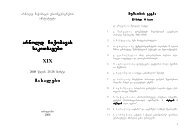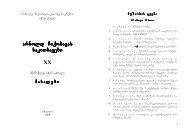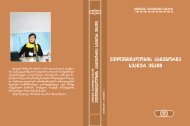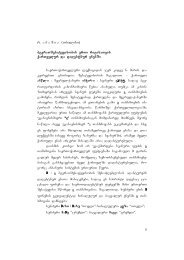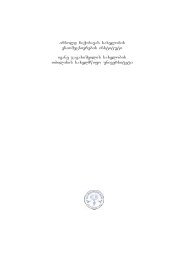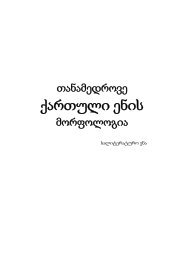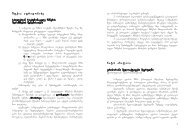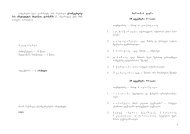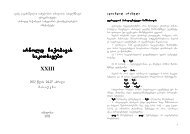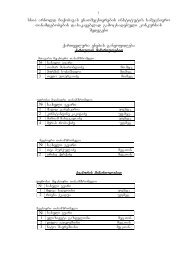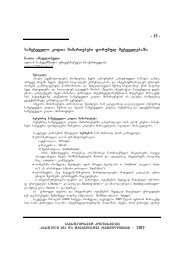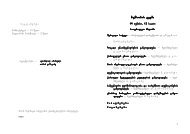iberiul-kavkasiuri enaTmecniereba XXXIX
iberiul-kavkasiuri enaTmecniereba XXXIX
iberiul-kavkasiuri enaTmecniereba XXXIX
You also want an ePaper? Increase the reach of your titles
YUMPU automatically turns print PDFs into web optimized ePapers that Google loves.
Tavazianobis etiketi da mesame piris nacvalsaxelTa sistema<br />
Pronoun tamusē belongs to the literary lexical fund of Sinhala language. It<br />
expresses politeness in literary language and means “your honors”(Gunasekera<br />
1892:162) but in modern colloquial register of Spoken Sinhala it has an offensive<br />
meaning. Moreover, using this form causes a reason for encouraging an addressee to<br />
incline for fight can be caused. It has quite unprintable meaning and is used only in<br />
addressing lower socio class. This example reminds us an addressing form<br />
“vazhbatono” in Georgian, which nowadays has an offensive meaning, while its female<br />
counterpart ”kalbatono” could maintain its polite meaning in modern using. But in<br />
Georgian we don’t have such a rigorously distinguished system of social diversity which<br />
is expressed in Sinhala language by using appropriate forms.<br />
For addressing higher socio status or rank representative obətumā (ā male marker<br />
) and obətumī (ī female marker) are used. These forms are composed by : obə (the 2nd<br />
personal pronoun with very polite meaning, used only in Literary language) + tum<br />
which is a special element for expressing a politeness, it can be added to the 3rd person<br />
pronouns too, like: etuma, metuma ( he-polite form) also to a proper nouns, like<br />
Jayətiləkətumā (=his honors Mr. Jayatilaka) .<br />
In addressing high religious persons, such as Buddhist monks obəvahansē is<br />
used. It is formed as follows: obə ( polite “you”) +vahansā; Literary: vahan “sandals”,<br />
shoes, cf. Pali : upāhanā cf. Sanskrit: upāhansē > sey ”manner” (Geiger 1938: 32;17 )<br />
Why did above discussed subject become the focus of our special interest?<br />
We paid our attention to the existence of the different forms which denote the<br />
2nd personal pronouns in the dictionary. But their using opportunities were not<br />
systematically described in that special literature which has been available for us at<br />
present. Of course, it is not beyond any doubt that several scholars had done a really<br />
significant work in studying pronouns (Geiger, Gunasekera) but our interest was<br />
focused on modern language situation.<br />
Also, there is another important reason due to the benefit of learners of Sinhala.<br />
Anyone who will depend only on the dictionary and takes an arbitrary choice of the<br />
2nd personal pronoun forms, will face to an awkward situation. It is not reasonable to<br />
use different forms without knowing etiquette.<br />
Thus, this work is supposed to give some help for those who learn Sinhala and<br />
are eager to communicate properly . We think, this article could be also useful for<br />
those, who like to prepare translations into Sinhala and finally, it is helpful as a material<br />
for studying some socio linguistic issues. It is noteworthy that except these 2nd<br />
personal pronouns, the 3rd personal pronouns are specified in Sinhala according to<br />
their numerous numbers and semantic-functional diversity as well and they interestingly<br />
show how the society is socially distinguished or differentiated through the social<br />
status or ranks. This will be the subject of our next study.<br />
57



